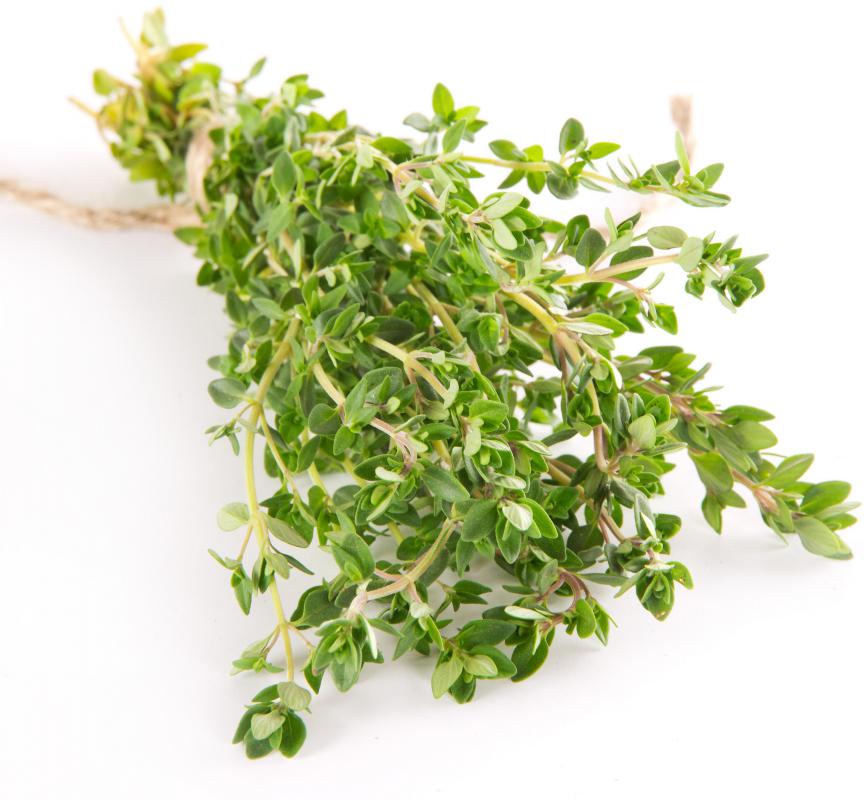At WiseGEEK, we're committed to delivering accurate, trustworthy information. Our expert-authored content is rigorously fact-checked and sourced from credible authorities. Discover how we uphold the highest standards in providing you with reliable knowledge.
What Are the Best Tips for Planting Thyme?
Successfully planting thyme, whether indoors or outdoors, is relatively easy as it is a hardy herb that can flourish under most natural conditions. Thyme seed takes six to 12 days to germinate, and planting thyme outdoors should only be done when all danger of frost is past. Growing herbs indoors, however, can be done year-round, and, though thyme prefers full sun, it will grow well with partial sun and under standard fluorescent lights as well.
There are about 350 species of thyme herb, but the most common varieties are widespread and hardy plants that require little attention in order to thrive. When planting thyme, it is okay to miss routine watering periods as it likes dry conditions, and will grow well in rocky soils and along borders. Common and popular varieties of thyme include Thymus x citriodorus Aureus, which is lemon-scented, and T.pseudolanuginosus known as Wooly Thyme, which spreads out as a soft sort of ground cover. Caraway Thyme, or T.herba-barona, is also low-growing with pale pink flowers and has a scent reminiscent of caraway seed. Perennial in nature, once planted in a garden, thyme will continue to come back year after year.

Growing herbs from a seed may seem like a tedious process at first, as herbs like thyme are slow to take off initially. Some garden experts recommend not harvesting it at all the first year, but, if it is thriving, cuttings can be taken in mid-summer right before it begins to flower, and it will continue to grow until frost hits in the fall. Over-watering or over-fertilizing when planting thyme will prove detrimental to its growth, and, in fact, it shouldn't need fertilizer at all unless the soil is extremely poor quality or lacking in organic nutrients.

Mulching the plant outdoors with straw can help to protect it from drought and cold temperatures. In the warm, wet southern United States, it can be prone to insect or disease damage outdoors, so it should be started indoors until thoroughly established before transplanting. After three to four years of growth, thyme will start to get woody and produce fewer leaves. At this point, it is necessary to remove it and plant fresh seed.
Planting thyme will usually yield a thriving, beautifully-flowered herb that has many ornamental and culinary uses, including as a flavoring for marinades and sauces. Uses for thyme can be traced back in the history of many cultures. It was grown by monasteries in Europe during the Middle Ages as a cough and digestive remedy and is used in modern antibacterial and anti-fungal treatments, as well as for respiratory ailments.
AS FEATURED ON:
AS FEATURED ON:












Discussion Comments
One of the things I like best about thyme is that it can be planted anytime of the year, and you will be able to harvest some of your own herbs. If you are wondering when to plant thyme outside, you need to wait until danger of frost has passed.
However, if you want some fresh herbs at your fingertips all year long to use in cooking, buy some seeds and place the pot in a sunny window. There are many different varieties of thyme, but if you like the scent of lemon like I do, there are lemon scented thyme seeds and plants that smell wonderful.
Thyme is a member of the mint family and honeybees love anything in the mint family. We have a few honeybee hives, and I planted some thyme in my garden just to attract some honeybees. I have found that it is very easy to grow thyme in my garden.
Another interesting thing about thyme is that thyme essential oil can be used when feeding honeybees to help keep mites from destroying the honeybee hives.
The history of thyme goes back a long ways, and there are so many medicinal and edible uses for it, that it has become one of my favorite herbs.
Post your comments